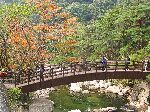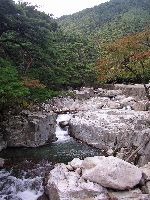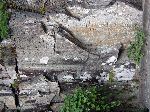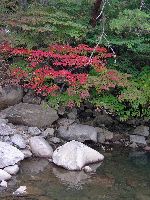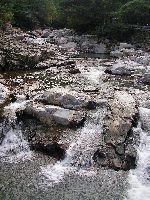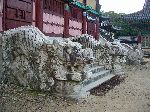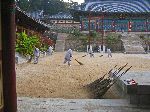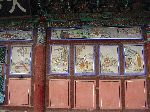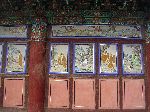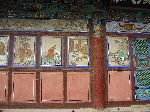Ibike Korea People-to-People Program
 Photo essay:
Gayasan and Haeinsa
Photo essay:
Gayasan and Haeinsa
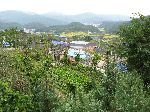
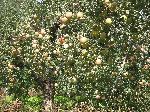 After leaving the valley floor, heading
up to Gayasan, the predominate agriculture is apples. At this time the
trees were heavily laden and roadside vendors were selling apples by the case.
Bicyclists seem to be a special case. I have never bicycled up the
mountain without being offered a free apple or a half dozen -- just the
validation helps keep the chin up and the legs a little stronger.
After leaving the valley floor, heading
up to Gayasan, the predominate agriculture is apples. At this time the
trees were heavily laden and roadside vendors were selling apples by the case.
Bicyclists seem to be a special case. I have never bicycled up the
mountain without being offered a free apple or a half dozen -- just the
validation helps keep the chin up and the legs a little stronger.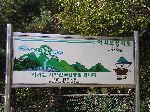
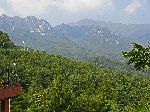 Gayasan (mountain) is part of the Sobaik Mountain
Range. It is part of Gayasan National Park, and is considered a spiritual mountain and one of the eight scenic
places in Korea. Scenic places come in groups of eight: There are the
eight most scenic place in a county, on a coast, in the mountains, etc.
But Gayasan is at the top because it is one of the eight best in the country.
It is a popular hiking destinations for Koreans.
Gayasan (mountain) is part of the Sobaik Mountain
Range. It is part of Gayasan National Park, and is considered a spiritual mountain and one of the eight scenic
places in Korea. Scenic places come in groups of eight: There are the
eight most scenic place in a county, on a coast, in the mountains, etc.
But Gayasan is at the top because it is one of the eight best in the country.
It is a popular hiking destinations for Koreans.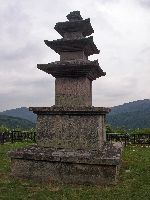
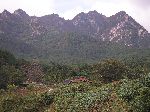 This pagoda stands alone high in the
Gaya
Mountains, at the former site of Peopusa (temple), built during the reign of
Aejangwang (r. 800-809) of the Unified Silla Kingdom. The pagodas double
base and three stories are typical pagodas of the Unified Silla period
(668-918). Pagoda always had an odd number of stories.
This pagoda stands alone high in the
Gaya
Mountains, at the former site of Peopusa (temple), built during the reign of
Aejangwang (r. 800-809) of the Unified Silla Kingdom. The pagodas double
base and three stories are typical pagodas of the Unified Silla period
(668-918). Pagoda always had an odd number of stories.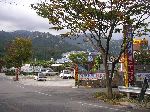
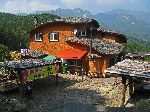
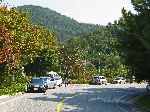 The
National Parks policy in Korea does not include trying to keep them in pure
natural states. There are new large enclave hotels and roadside commercial
buildings. Even high in the Gaya mountains you can find a
curtain of advertising signs. Signs for advertising and announcing events are nearly omnipresent across the country.
The
National Parks policy in Korea does not include trying to keep them in pure
natural states. There are new large enclave hotels and roadside commercial
buildings. Even high in the Gaya mountains you can find a
curtain of advertising signs. Signs for advertising and announcing events are nearly omnipresent across the country.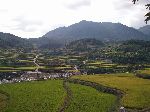
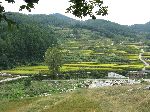 It seems to be difficult to catch the beauty of the
farms with the camera, despite dozens of attempts. Fortunately, even
without the perfect picture, we got to enjoy some very tranquil scenery.
It seems to be difficult to catch the beauty of the
farms with the camera, despite dozens of attempts. Fortunately, even
without the perfect picture, we got to enjoy some very tranquil scenery.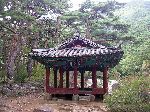
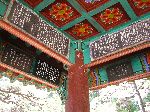 Nongsanjeong: This is the
retreat where Master Goun Choe Chiwon, a prominent Confucian scholar towards the
end of the Silla dynasty searched for truth. The inside of the pavilion
contains poems and writings of the Master.
Nongsanjeong: This is the
retreat where Master Goun Choe Chiwon, a prominent Confucian scholar towards the
end of the Silla dynasty searched for truth. The inside of the pavilion
contains poems and writings of the Master.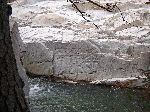
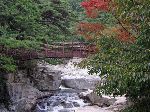 In the rocks in and around the river are etched
with an enormous amount of Chinese lettering. Some of it is identified as
poems and verse (i.e. graffiti carved in stone.) The scene was sweetened
with a little fall color (right).
In the rocks in and around the river are etched
with an enormous amount of Chinese lettering. Some of it is identified as
poems and verse (i.e. graffiti carved in stone.) The scene was sweetened
with a little fall color (right).
Scenic river, fall foliage, graffiti (actually spiritual messages) carved in stone and a horse monument are among many interesting sights that grace the road to Haeinsa.
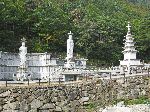
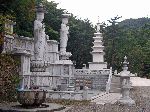 A large and elaborate monument
along the road into
the Gaya mountains, on the way to Haeinsa (temple) is part of Gilsang-am
(hermitage). Part of the importance of Gilsang-am is it includes
Jeokmyeolbogung, the pray place where Buddha's bones from Sri Lanka are
preserved. Indicative of its importance, gifts are frequently left at the
base of the statues.
A large and elaborate monument
along the road into
the Gaya mountains, on the way to Haeinsa (temple) is part of Gilsang-am
(hermitage). Part of the importance of Gilsang-am is it includes
Jeokmyeolbogung, the pray place where Buddha's bones from Sri Lanka are
preserved. Indicative of its importance, gifts are frequently left at the
base of the statues.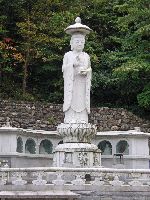
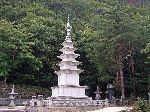
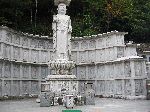
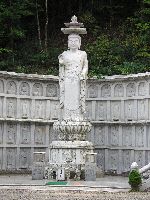 The pagoda has a double base and five stories.
The pagoda has a double base and five stories.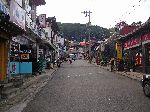
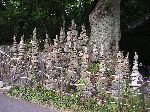
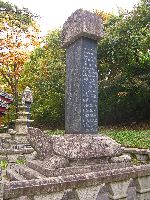 Approaching Haeinsa, and near other temples and
sometimes scenic locations, are mini-stupas-stacks-of-stones. These
are intended to invoke the Buddha.
Approaching Haeinsa, and near other temples and
sometimes scenic locations, are mini-stupas-stacks-of-stones. These
are intended to invoke the Buddha.There are also a number of other steles, monuments and pagodas commemorating important people associated with Haeinsa.
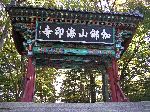

Before the Nirvana Gate (third gate) is the Kooksa Altar, In what is a fusion of Buddhism and local traditional religion, this altar houses the mountain god who manages the mountain and Guksa, the great god guarding a Buddhist temple. At Haeinsa, Jeongkyeonmoj, who was a founder of the temple and a patron saint of Gayasan, is enshrined here.
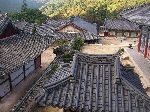
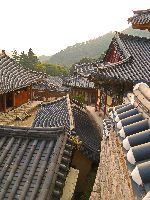 Haeinsa (temple) is one of the ten
main temples of the Hwaom sect. According to the Gayasan Hainsa Sunanjuwonbyukki written by
Choi Chi Won, Haeinsa was built by two monks named Suneung and Ijong in 802.
The name Haeinsa originated from :"Haein Sammae" of the Hwaom scriptures.
Haeinsa is the place where Hwaom ideas are accomplished.
Haeinsa (temple) is one of the ten
main temples of the Hwaom sect. According to the Gayasan Hainsa Sunanjuwonbyukki written by
Choi Chi Won, Haeinsa was built by two monks named Suneung and Ijong in 802.
The name Haeinsa originated from :"Haein Sammae" of the Hwaom scriptures.
Haeinsa is the place where Hwaom ideas are accomplished.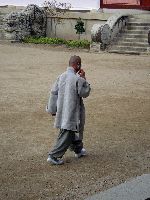
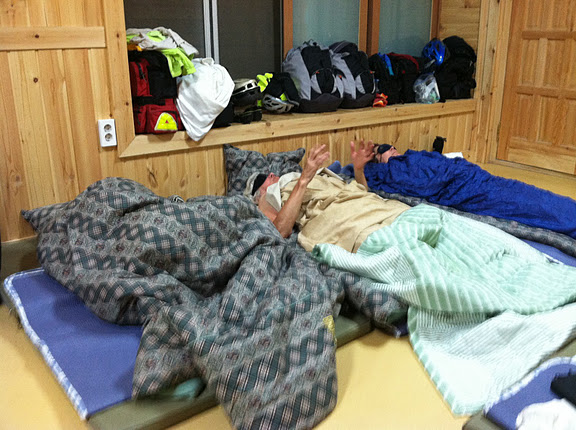 We were granted permission by the
monks to stay overnight (pre-arranged) at Haeinsa. The rooms are "ondol"
(heated floors, with mats to sleep on -- no beds) and no accessories, except for
electric lights -- though it is interesting reflect on the use of cell phones by
monks and the monetary now has a high speed internet connection.. Beside
touring the environs, as is expected of guests, we participated in the major
activities during the period of our brief stay: paying our respects to Buddha,
evening drum ritual, lights out at 9PM, 3:30 AM pray ceremony and 6 AM
breakfast.
We were granted permission by the
monks to stay overnight (pre-arranged) at Haeinsa. The rooms are "ondol"
(heated floors, with mats to sleep on -- no beds) and no accessories, except for
electric lights -- though it is interesting reflect on the use of cell phones by
monks and the monetary now has a high speed internet connection.. Beside
touring the environs, as is expected of guests, we participated in the major
activities during the period of our brief stay: paying our respects to Buddha,
evening drum ritual, lights out at 9PM, 3:30 AM pray ceremony and 6 AM
breakfast.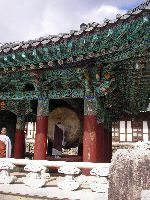
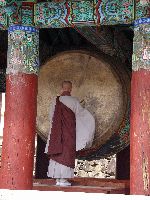 Major temples have a bell / drum
/ gong
pavilion, usually near the gate. There are four instruments: The hide covered drum calls animals of the land. The
wooden fish-shaped slit drum calls the creatures of the water. The
flat metal cloud-shaped gong calls the animals of the sky. And, the large bronze bell calls all
spirits.
They are played a couple time a day to alert all the creatures and spirits to
hear..
Major temples have a bell / drum
/ gong
pavilion, usually near the gate. There are four instruments: The hide covered drum calls animals of the land. The
wooden fish-shaped slit drum calls the creatures of the water. The
flat metal cloud-shaped gong calls the animals of the sky. And, the large bronze bell calls all
spirits.
They are played a couple time a day to alert all the creatures and spirits to
hear..
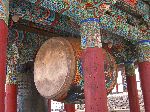
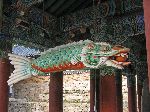
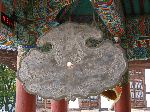
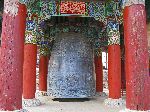
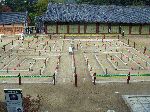
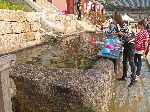 In front of the bell
pavilion is the Haeindo (Mandara), Buddhists believe that if they circle
around the stone design of the Haeindo (square maze) while praying their desires
will be accomplished.
In front of the bell
pavilion is the Haeindo (Mandara), Buddhists believe that if they circle
around the stone design of the Haeindo (square maze) while praying their desires
will be accomplished.Also in the plaza is a spring / drinking fountain that is said to have very pure water.
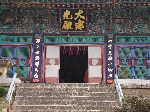
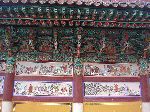 Haeinsa Daejeokgwangjeon, where the statue of
Birojanabul is enshrined as the main Buddha, is the central sanctuary of Hwaom
Buddhism in Korea. Through his actualization of the Buddha's teaching, which are
believed to be as brilliant as the sun that illuminates the heavens, Birojanabul
has become a figure symbolic of Buddhist truth itself. It was originally
built in 802.
Haeinsa Daejeokgwangjeon, where the statue of
Birojanabul is enshrined as the main Buddha, is the central sanctuary of Hwaom
Buddhism in Korea. Through his actualization of the Buddha's teaching, which are
believed to be as brilliant as the sun that illuminates the heavens, Birojanabul
has become a figure symbolic of Buddhist truth itself. It was originally
built in 802.
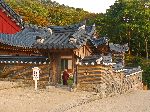 Most of the buildings at the temple
fall into two categories; living quarters and those used for prayer/study. There
are a number of shines used for pray. We joined the monks for their first
prays of the day at 3:30 a.m. They then do chore, have breakfast at 6 a.m. and then
study or pray in one of the shrines for the morning. The juxtaposition of
nature, the multiple graceful rooflines of the building, the changing light and
the ambiance of activity (including chanting), generates a very spiritual aura.
Most of the buildings at the temple
fall into two categories; living quarters and those used for prayer/study. There
are a number of shines used for pray. We joined the monks for their first
prays of the day at 3:30 a.m. They then do chore, have breakfast at 6 a.m. and then
study or pray in one of the shrines for the morning. The juxtaposition of
nature, the multiple graceful rooflines of the building, the changing light and
the ambiance of activity (including chanting), generates a very spiritual aura.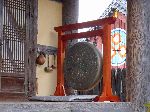
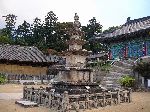
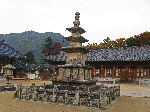 This pagoda, with its two part foundation, three
story structure and roof stone, is typical of the style of late Unified Shilla
(668-918). In 1926, during the renovation of this pagoda, nine small
individual Buddhist figure were discovered inside a stone chest on the uppermost
support. After renovation was completed, these statures were re-enshrined
in the pagoda.
This pagoda, with its two part foundation, three
story structure and roof stone, is typical of the style of late Unified Shilla
(668-918). In 1926, during the renovation of this pagoda, nine small
individual Buddhist figure were discovered inside a stone chest on the uppermost
support. After renovation was completed, these statures were re-enshrined
in the pagoda.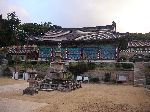
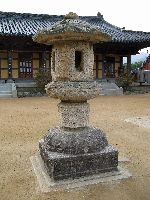 Stone lanterns were made to remove the darkness
within temples where Buddha rested. Because lanterns are connected to the
offering of lanterns for Buddha, they are usually located in front of the main
sanctuary together with stone pagodas representing Buddha.
Stone lanterns were made to remove the darkness
within temples where Buddha rested. Because lanterns are connected to the
offering of lanterns for Buddha, they are usually located in front of the main
sanctuary together with stone pagodas representing Buddha.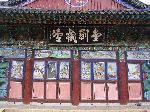
These panels illustrate events in Buddha's life.
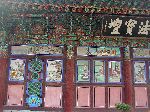 Both the interior and
exterior of the temples are elaborately painted. These exterior panels record
events important to Buddhism.
Both the interior and
exterior of the temples are elaborately painted. These exterior panels record
events important to Buddhism.Basic temple etiquette:
- Generally be quiet
- Wear long pants
- Don't enter a temple or room directly in front of Buddha, use a side door (some senior monks are given this privilege.)
-
Remove you shoes, but no bare feet (wear socks), when entering a temple.
- Pay your respect to Buddha by bowing three times
- Don't take pictures while inside a temple
- If you eat a meal, eat all the rice you take


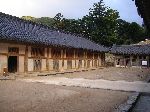 blocks of the Tripitaka Korean, a complete set
of Buddhist texts. The engraving was
preceded by four years of preparation and took place between 1237-48.
blocks of the Tripitaka Korean, a complete set
of Buddhist texts. The engraving was
preceded by four years of preparation and took place between 1237-48.Janggyeongpanjeon is composed of four buildings. They are presumed to have been built around 1448.
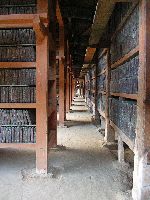
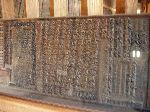 King Gojong. Daejanggyeong refers to a collection of all the scared
writings of Buddhism.
King Gojong. Daejanggyeong refers to a collection of all the scared
writings of Buddhism.Made to protect the nation with the power of Buddhism against the Mongolian Invasion, the Tripitaka Koreana is recognized as the most accurate Tripitaka in history. Sugidaesa (Sugi, the Great Buddhist Monk), who was in charge of the project, took care to correct errors after a thorough study of the Northern Song Tripitaka, the Kitan Tripitaka and the Old Tripitaka Koreana.
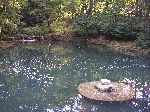
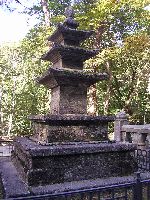
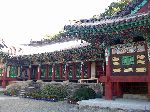

 Please
contact us if you would like to be added to
Ibike's mailing list or have questions, comments, corrections or criticism. (Also, please let us know how you learned about us and
found this site.) Privacy policy.
Please
contact us if you would like to be added to
Ibike's mailing list or have questions, comments, corrections or criticism. (Also, please let us know how you learned about us and
found this site.) Privacy policy.
![]() IBF Homepage
IBF Homepage ![]() Ibike Programs
Ibike Programs
![]() Ibike Schedule
Ibike Schedule
![]() Search
Search
